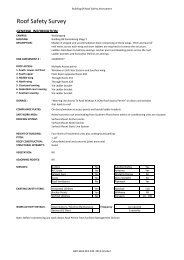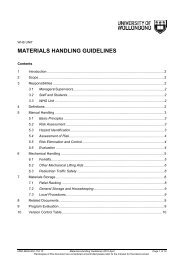Hui-ling Wang - Staff
Hui-ling Wang - Staff
Hui-ling Wang - Staff
You also want an ePaper? Increase the reach of your titles
YUMPU automatically turns print PDFs into web optimized ePapers that Google loves.
<strong>Hui</strong>-<strong>ling</strong> <strong>Wang</strong>Ph D student, part-time lecturer,occasional tutorSchool of Management & MarketingEmil: hwang@uow.edu.au
Research Interests and Prior Work• Academic Experience:– Part-time lecturer: UoW Business School, Wollongong UniversityCollege, Academy of IT (Sydney)– Occasional guest lecturing in Management (UoW)– Substitute teacher: TAFE– Offered continuing Assoc Lecturer position at Deakin (turned downfor family reasons)– Subjects I have taught: E-commerce, project management, crossculturalmanagement, quantitative methods, information systems,Introduction to Management and Employment Relations (alsotutored organizational behaviour)• Industry Experience:– An international law firm in Taipei– An international investment advisory firm involving Taiwan andCanada– Founded 2 .com startups– Consulted on cultural/language training for DIMIA
The Project to be Discussed I• Research interests: Strategy, B2B e-commerce, supplychain management (also, to a lesser degree, crossculturalmgmt.)• PhD Research: How do theories of strategy apply to B2Be-commerce (or eB2B)?• Key outcomes:– A systematic means of describing, analyzing andunderstanding eB2B– A novel view of strategy (interaction-level), motivated byeB2B considerations– A novel notion of strategic consistency that seems toprovide a good basis for explaining success/failure of eB2B– A framework for mode<strong>ling</strong> eB2B (hopefully extensible tomode<strong>ling</strong> supply chains)– Approx. 9 publications, including a best paper award.
B2B e-commerce decisions: strategic or operational ?Claim: B2B e-commerce (eB2B) decisions are strategic• eB2B requires that we focus on the configuration of a firm’sB2B interactions, while traditional B2B is focused on individualtransactions• eB2B configurations impact a firm’s market positioning(whether as a buyer or seller)• eB2B configurations have larger impact (both in physical andtemporal scope)• eB2B configuration decisions are on-going and long-term(traditional B2B decisions are situational, and medium- toshort-term in scope)• eB2B configuration decisions are about deployment ofresources (and not employment of resources)• eB2B configuration investments are significant, both in sizeand in impact to profitability
eB2B ConfigurationBusinessmodelsMarketmechanismsTechnologicalplatformsRelationshipselection• eB2B Configuration: the collection businesses models, market mechanisms,technological platforms and relationship selection criteria that determine howa firm conducts B2B e-commerce.
eB2B RelationshipsTraditional B2Bdecisions• Who should I do business with? On whatterms? At what price?B2Be-commercedecisions• What eB2B configuration should I use?
eB2B RelationshipsTraditional B2Bdecisions• Example:Australian iron-ore producers (miners) andJapanese steel makers determine the priceat which the latter would purchase iron-orefrom the former on an annual basis via aseries of meeting traditionally held in Japan.B2Be-commercedecisionsTransactionorientedConfigurationoriented• Example:General Electric’s buy-side(procurement) e-marketplace
Analyzing the Business Context:A Pyramidal ModelFrom Strategy point of view:
Interaction-level AnalysisInteraction-level analysis refers to the analysis ofindividual business arrangements of a specific firm.Business Arrangement– Business arrangement is any formal or informalbusiness contact between different businesspartners on trading, collaboration or anybusiness related activity. These activitiesinclude sharing business information, buying orsel<strong>ling</strong> goods and receiving or providingservices, or collaborating on communityprojects.
Interaction-level AnalysisNo analogue for interaction-level analysis exists inthe current literature on strategy– Hofer and Schendel (1978) define 4 hierarchical levelsof strategy: enterprise, corporate, business andfunctional. Interaction-level analysis is sub-functional.– Dyer and Singh (1998) define relational view ofstrategy. The unit of analysis is inter-organizational (anetwork or coalition of firms). Interaction-level analysisviews the problems from the perspective of a singlefirm, and is more fine-grained.
Interaction-level View of StrategyAddresses need for intra-organizational units of analysis andcorresponding conceptions of strategic thinking
Interaction-level View of StrategyDistinct from application of MBV or RBV notions to smallerunits of analysis– MBV or RBV-based analysis may yield very different(even inconsistent) pictures in the same businesscontext• e.g., a large firm may have high bargaining powerdue to size and positioning in a market, but may havelower bargaining power in the instance of a specificproduct (possibly due availability of substitutes)– Interaction-level strategy must be constrained byorganizational strategy – these are constraints ofstrategic consistency
Strategic ConsistencyA pair of strategies are inconsistent if any of thefollowing hold:– The two strategies lead to contradictoryeffects, e.g. a strategy that seeks to increase R&Dfunding and another that seeks to cut costs byreducing R&D funding– The two strategies have resourcerequirements that cannot be simultaneouslysatisfied
Strategic Consistency• Notion of strategic consistency is verygeneral• It is applicable in any situation involvinghierarchical decomposition of strategy• Such constraints would apply if strategiesformulated by sub-organizational unitsneeded to be consistent with organizationalstrategy
Potential for Academic Collaboration• Management: many possibilities….• Information Systems: many possibilities….• Marketing: B2B relationship management, supplierrelationship management, CRM, eMarketing• Accounting: B2B and supply chain audits basedon explicit models (of desired states of affairs)??• Economics: Some existing work on quantitativemodels to support design of eB2B markets – thismight be of interest?• My secondary interest in cross-cultural influenceson strategy
Potential for Industry Collaboration• eB2B and supply chain strategy: many possibilitiesfor medium to large firms (possibly even SMEs)• eB2B and supply chain mode<strong>ling</strong>: similarly manypossibilities• Case study of bluescopesteelconnect.com – tohappen soon! (secondary data being analyzed)• Other case studies: corprocure.com.au (nowAustralia Post) - many others based on secondarydata
Personal Areas of SuccessGood at something ?? Me ??
Discussion Points for the Audience• How can I get research grants without holdingan academic appointment?• I would like to collaborate…
















